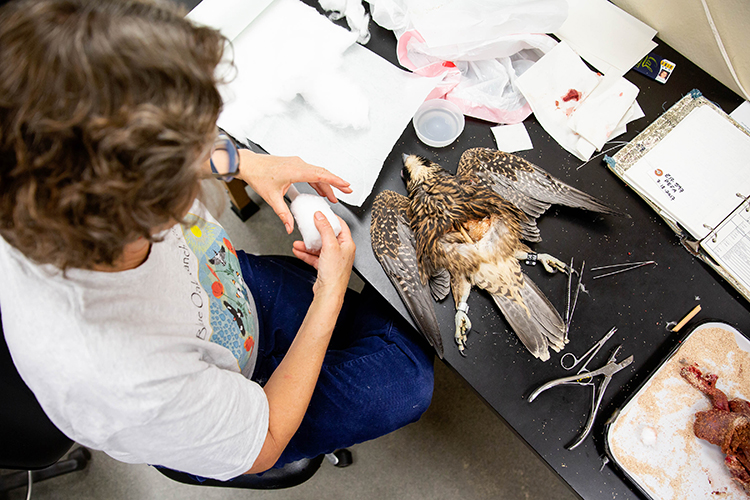Podcast transcript: At Berkeley, nobody stuffs a bird like Carla Cicero

September 25, 2018
[Music: “The Zeppelin” by Blue Dot Sessions]
You’re listening to Fiat Vox, a podcast that gives you an inside look at why people around the world are talking about UC Berkeley. It’s produced and hosted by me, Anne Brice, a reporter for Berkeley News in the Office of Communications and Public Affairs.
[Natural sound: Freezer door opens and closes.]
Carla Cicero: We have a walk-in freezer there where we keep specimens.
Me: How cold is it?
Carla: Minus 26 degrees.
I’m in a lab in the basement of the Museum of Vertebrate Zoology at UC Berkeley. In one corner, a set of antlers soak in a tub of water. In another, beetles are snacking on a skull. When I look up, a giant wandering albatross stares back at me.
[Music: “Spunk Lit” by Blue Dot Sessions]
Carla Cicero is the staff curator of birds for the museum. She’s about to prepare a bird for its collection made up of about 750,000 amphibians, reptiles, birds and mammals. There are some 190,000 birds in the collection.
Today, she’s preparing a bird that many of us know as Lux — the peregrine falcon that was born on the Campanile last year and died after striking a window of Evans Hall. She records meticulous data about each specimen.
Carla: This is my catalogue of stuff that I’ve prepared this year — a lot which which I’ve collected — and I assign my own number.
Anne Brice (host): Is that like, 4,200 or…
Carla: 4,287 yeah. So that means I’ve prepped 4,287.
Anne: This year?
Carla: No no. Since I started, so it’s been about 30 years. Probably just about 30 years.
Lux’s body is going to become a study skin — something that researchers at UC Berkeley and across the world can use in all kinds of research.
[Natural sound: Carla working on a specimen]
Preparing a study skin takes a lot of patience and attention to detail.
Carla: What I like about it is, it’s a mixture of science and art. The science part is this and taking the tissue and measurements and all that stuff. Then the art part is actually making a nice-looking skin out of it.
And you have to have a strong stomach. This is not a job for the squeamish. During the prep — which took about three hours — there was a lot of bone crunching.
Carla: So this is the other humerus. I need to break the bone is what I need to do… [crunching sound]
Anne: Oh man, the crunching does kind of get to me a little bit…
Carla: Does it? [laughs]
[Music: “Building the Sled” by Blue Dot Sessions]
The museum was founded in 1908, but the oldest specimen — a shorebird called a Red Knot collected in England — dates back to 1836. All of the specimens are listed in an online collections database called Arctos.
The museum acquires specimens in several ways. Students and other researchers collect them in the field. Wildlife rehab centers and zoos donate animals that have died. The U.S. Fish and Wildlife Service sometimes confiscates animals at customs.
And one thing that surprised me is that the public drops off a lot of dead animals at the museum, too.
Carla says it’s actually against the law to pick up a bird or its part — even a feather — without a permit. Every bird fits into this category except rock pigeons, European starlings and house sparrows, which have all been introduced to the area.
Carla: North American birds are protected by law by the Migratory Bird Treaty Act, so anything we do, of course, we have to get permits to collect. We also have permits to salvage and to accept things.
But, she says, as long as you bring a dead bird to a museum, there’s a kind of unwritten good Samaritan clause that makes it ok. But if you keep it for your own collection, you’re committing a felony.
Carla: So now I’m going to turn the skin right side out. Now the fun begins. So basically you just roll it like a sock.
But Carla isn’t done with the study skin yet. She still has to clean it, replace the brain, eyes and body with carefully rolled-up cotton, then put in a small wooden dowel to kind of hold it all in shape. After that, she stitches it together and sets it out to dry.
[Music: “Contrarian” by Blue Dot Sessions]
Then, after a few weeks after it’s totally dry, she’ll freeze it to make sure all the pests are dead, and then it’ll go into a drawer with the other peregrine falcons from the area as part of the collection. It’s a vast resource that Carla hopes is around for as long as we are.
Learn more about the Museum of Vertebrate Zoology, visit mvz.berkeley.edu.
For Berkeley News, I’m Anne Brice.
You can subscribe to the Fiat Vox podcast on Apple Podcasts or wherever you listen to your podcasts. For more UC Berkeley News, visit news.berkeley.edu. And if you have a great story idea, send us an email at [email protected].